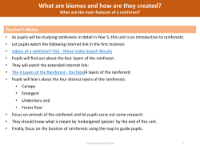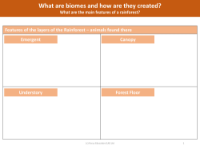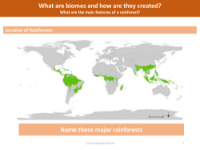What are the main features of a rainforest? - Presentation

Geography Resource Description
Rainforests are incredibly complex and vibrant ecosystems, characterised by their tall, dense trees and high levels of rainfall. These forests are divided into two main types: tropical and temperate, each offering a unique environment teeming with a wide array of plant and animal life, contributing to their immense biodiversity. One of the key features of rainforests is their stratification into distinct layers, each with its own set of flora and fauna adapted to the conditions found there. These layers include the emergent, canopy, understory, and forest floor, with each providing a unique habitat and playing a crucial role in the overall structure of the rainforest.
The emergent layer, which is the highest stratum, features towering trees that reach heights comparable to skyscrapers, providing a home for various species of monkeys, birds, and insects. Below this is the canopy layer, where the dense foliage of canopy trees blocks out most of the sunlight and rainfall, creating a habitat rich in animal life. The understory layer is a darker, more humid environment with limited sunlight, supporting the growth of small shrubs, moss, and algae, and is home to numerous insects and reptiles. Finally, the forest floor is the lowest level, where despite the poor soil quality, a rapid cycle of decay of plant debris enriches the ground, supporting a diverse array of insects and larger mammals such as tigers, gorillas, elephants, and anteaters. Understanding these layers and their inhabitants is crucial for grasping the complexity and importance of rainforest ecosystems.






